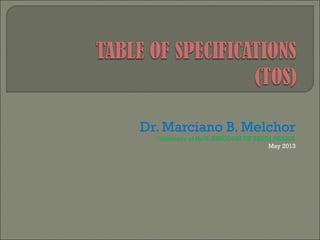
Table of specifications 2013 copy
- 1. Dr. Marciano B. Melchor University of Ha’il, KINGDOM OF SAUDI ARABIA May 2013
- 2. A Table of Specifications is a two-way chart which describes the topics to be covered by a test and the number of items or points which will be associated with each topic.
- 3. Kubiszyn & Borich, (2003) emphasized the following significance and components of TOS: 1. A Table of Specifications consists of a two- way chart or grid relating instructional objectives to the instructional content. The column of the chart lists the objectives or "levels of skills" (Gredlcr, 1999) to be addressed; The rows list the key concepts or content the test is to measure.
- 4. According to Bloom, et al. (1971), "We have found it useful to represent the relation of content and behaviors in the form of a two dimensional table with the objectives on one axis, the content on the other”.
- 5. 2. A Table of Specifications identifies not only the content areas covered in class, it identifies the performance objectives at each level of the cognitive domain of Bloom's Taxonomy. Teachers can be assured that they are measuring students' learning across a wide range of content and readings as well as cognitive processes requiring higher order thinking.
- 6. 3. A Table of Specifications is developed before the test is written. In fact it should be constructed before the actual teaching begins.
- 7. 4. The purpose of a Table of Specifications is to identify the achievement domains being measured and to ensure that a fair and representative sample of questions appear on the test.
- 8. Carey (1988) pointed out that the time available for testing depended not only on the length of the class period but also on students' attention spans.
- 9. 1. A true-false test item takes 15 seconds to answer unless the student is asked to provide the correct answer for false questions. Then the time increases to 30-45 seconds. 2. A seven item matching exercise takes 60-90 seconds.
- 10. 3. A four response multiple choice test item that asks for an answer regarding a term, fact, definition, rule or principle (knowledge level item) takes 30 seconds. The same type of test item that is at the application level may take 60 seconds.
- 11. 4. Any test item format that requires solving a problem, analyzing, synthesizing information or evaluating examples adds 30-60 seconds to a question.
- 12. 5. Short-answer test items take 30-45 seconds. 6. An essay test takes 60 seconds for each point to be compared and contrasted.
- 13. If an individual can perform the most difficult aspects of the objective, the instructor can "assume" the lower levels can be done. However, if testing the lower levels, the instructor cannot "assume" the individual can perform the higher levels.
- 14. The cornerstone of classroom assessment practices is the validity of the judgments about students’ learning and knowledge. A TOS is one tool that teachers can use to support their professional judgment when creating or selecting test for use with their students.
- 15. In order to understand how to best modify a TOS to meet your needs, it is important to understand the goal of this strategy: improving validity of a teacher’s evaluations based on a given assessment. Validity is the degree to which the evaluations or judgments we make as teachers about our students can be trusted based on the quality of evidence we gathered (Wolming & Wilkstrom, 2010).
- 16. From the literatures we have known that standardized tests are valid. The question needs to he asked if GPAs are a valid measures of student achievement? GPAs are based in large measure on teacher made tests. If teacher made tests are not valid, how can a students GPA be valid? The use of a Table of Specifications can provide teacher made tests validity (Notar, Charles, 2004).
- 17. Lei, Bassiri and Schultz,(2001) found that a college GPA was an unreliable predictor of student achievement. Since we assume that norm referenced tests are valid measures, the tendency is to put more weight on those results concerning student achievement.
- 18. According to Ooster (2003) the faculty made tests will likely have poor content validity, "cause for concern because each assessment instrument depends on its validity more than on any other factor."
- 19. A Table of Specifications benefits students in two ways. First, it improves the validity of teacher-made tests. Second, it can improve student learning as well.
- 20. A Table of Specifications helps to ensure that there is a match between what is taught and what is tested. Classroom assessment should be driven by classroom teaching which itself is driven by course goals and objectives. Tables of Specifications provide the link between teaching and testing. (University of Kansas, 2013)
- 21. Teachers can collaborate with students , teachers or colleagues on the construction of the Table of Specifications: what are the main ideas and topics, what emphasis should be placed on each topic, what should be on the test? Open discussion and negotiation of these issues can encourage higher levels of understanding while also modeling good learning and study skills.
- 22. THANK YOU …..
